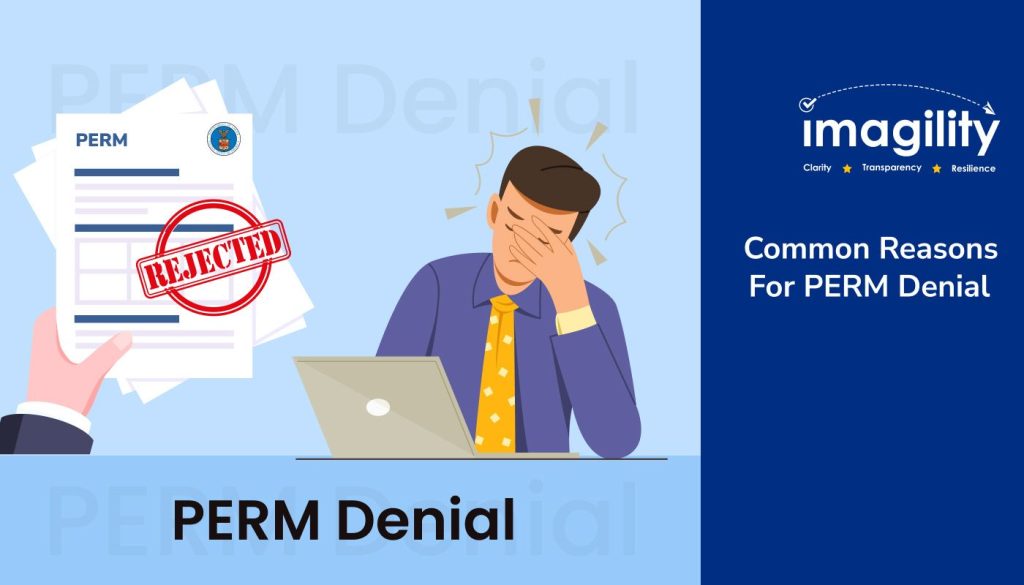Table of Contents
What is PERM?
Common PERM Denial Reasons
Insufficient Job Requirements
Inadequate Recruitment Efforts
Wage Issues
Documentation Errors
Failure to Respond to Audits or Requests for Evidence (RFEs)
Violation of Recruitment Regulations
Strategies to Avoid PERM Denials
Steps to Take If Your PERM Application Is Denied
Conclusion
The Permanent Labor Certification (PERM) process serves as a pivotal gateway for employers seeking to hire foreign workers for permanent employment in the United States. However, despite meticulous preparation and adherence to regulations, PERM denials can occur, leading to setbacks and frustrations.
In this blog, we will explore the intricate world of PERM denial reasons. From insufficient job requirements to documentation errors and wage issues, we explore the common pitfalls that applicants encounter. We will provide insights into strategies to avoid denials and steps to take if your application is denied.
Let’s start,
What is PERM?
The PERM process, administered by the Department of Labor (DOL), is a critical step for employers seeking to sponsor foreign workers for permanent employment-based immigration. It requires employers to demonstrate that there are no willing, able, and qualified U.S. workers available for the position being offered to the foreign worker.
Once approved, the PERM certification serves as the basis for the subsequent stages of the employment-based immigration process, such as filing the immigrant visa petition with U.S. Citizenship and Immigration Services (USCIS).
Insufficient Job Requirements
This refers to vague or unclear job descriptions, inadequately documented job duties, or unrealistic educational requirements, which may suggest an attempt to disqualify U.S. workers unfairly.
Inadequate Recruitment Efforts
This encompasses insufficient or ineffective recruitment methods to test the labor market for qualified U.S. workers. Failure to advertise the job opening widely or neglecting to reach out to appropriate professional organizations may result in denials.
Wage Issues
Denials may occur due to incorrect determination of prevailing wages for the occupation and geographic area. Employers must ensure compliance with prevailing wage requirements and provide evidence of offering the prevailing wage to both U.S. and foreign workers.
Documentation Errors
Mistakes, inconsistencies, or omissions in PERM application forms, supporting documents, or recruitment records can lead to denials. It is essential to review all documentation meticulously to ensure accuracy and completeness before submission.
Failure to Respond to Audits or Requests for Evidence (RFEs)
Ignoring audit notifications or providing insufficient responses to Requests for Evidence (RFEs) from the DOL can result in denials. Timely and comprehensive responses to inquiries are critical for successful applications.
Violation of Recruitment Regulations
Non-compliance with DOL regulations regarding recruitment methods, advertising requirements, or record-keeping obligations may lead to denials. Employers must adhere to specific recruitment requirements and maintain detailed records to avoid violations.
Strategies to Avoid PERM Denials
- Conduct thorough research and preparation before initiating the PERM process.
- Ensure that job descriptions and requirements are accurate, specific, and genuine.
- Implement robust recruitment strategies to test the labor market effectively.
- Maintain meticulous records of all recruitment efforts and document compliance with DOL regulations.
- Seek guidance from experienced immigration attorneys or consultants to navigate the complexities of the PERM process.
Steps to Take If Your PERM Application Is Denied
- Review the denial notice carefully to understand the reasons for denial.
- Consider appealing the decision if there are grounds for reversal or reconsideration.
- Consult with immigration attorneys or experts to assess your options and develop a strategy for reapplication.
- Take corrective actions to address any deficiencies or issues identified in the initial application.
- Prepare a comprehensive and well-documented reapplication to strengthen your case for approval.









